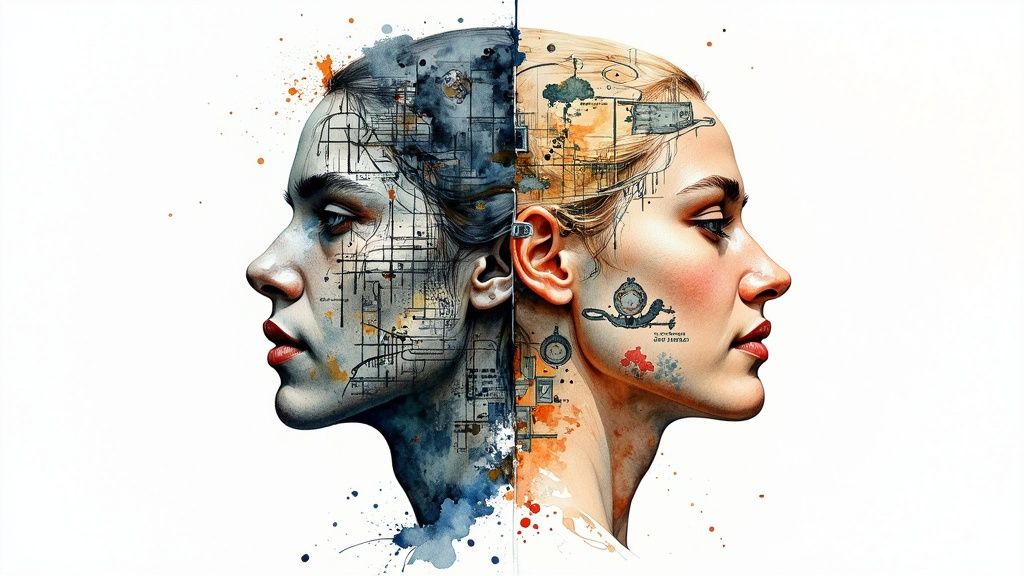
Master Creative Problem Solving Methods: A Step-by-Step Guide to Breakthrough Solutions
Breaking Down the Barriers to Creative Problem Solving

Mental barriers often hold us back from discovering the best solutions to problems. When we get stuck in a fixed mindset and believe our abilities can't grow, we tend to avoid taking risks or trying new approaches. Similarly, fear of failure can stop us from even attempting to solve difficult challenges. These mental roadblocks limit our problem-solving potential and prevent us from exploring creative possibilities.
Identifying and Overcoming Mental Blocks
The first crucial step is recognizing when our assumptions and preconceptions are getting in the way. Many people unconsciously accept limiting beliefs about what solutions are possible without questioning them. Getting past these mental blocks requires actively seeking out different viewpoints and perspectives. For instance, talking to people from varied backgrounds helps us see problems in new ways – much like traveling to a new place opens our eyes to different ways of thinking and doing things.
Cultivating a Growth Mindset for Creative Problem Solving
Seeing challenges as opportunities to learn and improve is essential for creative problem-solving. Rather than viewing setbacks as failures, we can treat them as valuable feedback to guide our next attempts. Consider how musicians learn complex pieces – each mistake shows them what needs more practice and refinement. This mindset helps build persistence and resilience when tackling difficult problems.
Managing Creative Anxiety and Building Resilience
Complex problems often trigger anxiety and uncertainty, which can derail the creative process. However, successful problem-solvers develop specific strategies to handle these feelings. Breaking big challenges into smaller, more manageable pieces makes them feel less overwhelming. Taking time to practice mindfulness and self-compassion also helps stay grounded when feeling stuck. This balanced approach prevents discouragement and allows steady progress toward solutions, even when the path forward isn't clear. By accepting that creative problem-solving is often messy and non-linear, we can keep moving forward despite temporary setbacks.
Mastering the Five-Stage Creative Process
Understanding how to break down creative challenges into clear steps makes the difference between random attempts and real solutions. The five-stage creative process provides a tested framework that guides you systematically from understanding a problem through implementing an effective solution.
Stage 1: Fact-Finding – Unearthing the Truth
Successful problem-solving starts with thorough investigation, like a detective working a case. During fact-finding, you dive deep beneath surface issues to understand root causes and context. This means conducting interviews, analyzing data, reviewing documentation, and observing the situation firsthand. For instance, if sales are declining, fact-finding might reveal that the real issue isn't the product but rather misaligned marketing targeting the wrong customer segments.
Stage 2: Problem-Finding – Defining the Challenge
Armed with facts, the next step is precisely defining the core challenge. This often means reframing the initial problem based on new insights. For example, what seems like "low sales" during initial assessment might actually be "ineffective marketing to the wrong audience" after fact-finding. Getting this definition right is crucial since it shapes all subsequent solution development. The clearer and more accurate the problem statement, the more focused and effective the solution process becomes.
Stage 3: Idea-Finding – Generating Creative Solutions
With a clear problem definition, it's time to generate potential solutions through techniques like brainstorming, mind mapping, and lateral thinking. The goal in this stage is quantity and variety – pursuing both practical and unconventional ideas. Just as casting a wide fishing net increases your chances of a good catch, generating many diverse solution ideas improves your odds of finding breakthrough approaches. Even seemingly impractical ideas can trigger unexpected connections leading to innovative solutions.
Stage 4: Solution-Finding – Evaluating and Refining Ideas
This stage focuses on critically analyzing the pool of ideas to identify and develop the most promising solutions. Like a sculptor carefully chipping away at stone to reveal the statue within, you evaluate each option's feasibility, costs, and potential impact while remaining objective. Often, the best approach combines elements from multiple ideas into a more complete solution. The key is maintaining rigor in assessment while staying open to refining and improving concepts through iteration.
Stage 5: Acceptance-Finding – Implementing and Adapting the Solution
The final stage centers on putting solutions into action through careful planning and execution. This requires clear communication, anticipating obstacles, and developing contingency plans. Just as a rocket requires constant course corrections to reach its destination, solutions need ongoing monitoring and adjustment to stay on track. Making implementation an iterative process allows you to refine the solution based on real-world feedback and changing conditions. This commitment to continuous improvement ensures the solution remains effective over time.
Building Your Creative Problem-Solving Toolkit

Now that we've explored the five stages of the creative process, it's time to add specific problem-solving methods to your toolkit. Just as a carpenter needs various tools beyond just a hammer, effective problem-solvers need multiple techniques to address different types of challenges. This diverse set of approaches allows you to tackle problems both systematically and creatively.
Lateral Thinking: Breaking Free From Linearity
Sometimes the most straightforward solutions aren't the best ones. Lateral thinking pushes us to question our usual thought patterns and explore new approaches. Consider a city's traffic congestion problem – while building more roads might seem like the obvious fix, lateral thinking might suggest flexible work hours or better public transit to reduce cars on the road in the first place. This shift in perspective often leads to simpler, more affordable solutions that address root causes rather than symptoms.
SCAMPER: A Checklist for Creative Exploration
The SCAMPER method provides clear steps for generating new ideas by examining a problem from different angles. Each letter represents a different approach: Substitute, Combine, Adapt, Modify/Magnify/Minify, Put to other uses, Eliminate, and Reverse. For example, when improving a product, you might ask: "What materials could we substitute?" or "How could we combine this with something else?" This structured approach helps you thoroughly explore possibilities using existing resources in fresh ways.
The Six Thinking Hats: A Multifaceted Perspective
Edward de Bono's Six Thinking Hats method helps examine problems from six distinct viewpoints: White (facts), Red (emotions), Black (risks), Yellow (benefits), Green (creativity), and Blue (process). For instance, when evaluating a new business proposal, you'd consider hard data (White Hat), potential risks (Black Hat), and emotional impact (Red Hat). This method prevents teams from getting stuck in one mindset and ensures all aspects of a problem receive proper attention.
Choosing the Right Tool for the Job
The key to effective problem-solving is knowing which method fits each situation. While brainstorming works well for initial idea generation, SCAMPER excels at improving existing solutions. Complex business challenges often benefit from the Six Thinking Hats to ensure balanced decision-making. By practicing these different approaches, you'll develop the judgment to select the most appropriate technique for each challenge. Remember, real-world problems rarely fit a single mold – flexibility in your approach leads to better solutions.
Leading Effective Group Problem-Solving Sessions
Group problem-solving is powerful when done right. While bringing people together is a start, the real key lies in skilled facilitation and a clear process that helps teams turn different viewpoints into practical solutions.
Establishing a Conducive Environment
Success starts with creating an atmosphere where everyone feels safe to contribute. Groups need clear ground rules about respectful communication and an understanding that unconventional ideas are welcome. Think of it like a jazz band – each musician needs to feel free to improvise for the group to create something special together. When people feel comfortable building on each other's ideas, the solutions that emerge are often more thoughtful and complete.
Structuring the Session for Success
Just as architects rely on blueprints, effective group sessions need a clear framework. This means spelling out goals at the start, setting aside enough time for each phase of the creative process, and using tools like whiteboards or shared documents to record ideas. A well-planned structure keeps everyone focused and prevents aimless discussions that lead nowhere.
Guiding the Group Through Creative Problem Solving Methods
The facilitator plays a vital role in steering the group through different problem-solving techniques. This could involve leading brainstorming, using SCAMPER to spark fresh thinking, or applying Six Thinking Hats to examine issues from new angles. When the group gets stuck, the facilitator can suggest role-playing or introduce thought-provoking questions to get ideas flowing again. This active guidance helps maintain momentum and achieve real results.
Managing Group Dynamics and Ensuring Equal Participation
Like an orchestra conductor, skilled facilitators make sure every voice is heard. They encourage quieter members to speak up while tactfully managing those who might dominate discussions. By fostering shared ownership and showing that all perspectives matter, facilitators help groups tap into their collective wisdom. Clear communication and mutual respect turn what could be chaos into focused, productive problem-solving that leads to practical solutions everyone can support.
Implementing Solutions That Actually Stick

Having good ideas and creative solutions is just the first step. The real challenge lies in putting those solutions into action and making them work over the long term. Success requires careful planning, continuous adjustments based on feedback, and a strong focus on measuring actual results.
Overcoming Resistance to Change
When implementing new solutions, many organizations face pushback from team members who are comfortable with existing processes, even if those processes aren't working well. The key to managing this resistance is clear communication about what drives the change. For example, showing how a new approach directly fixes specific problems or saves time can help build support. Getting input from team members early on and adapting plans based on their feedback also helps create ownership and reduce resistance.
Building Stakeholder Buy-In
Getting key stakeholders on board is essential for any solution to work. This means identifying everyone affected by the changes and adjusting how you communicate with different groups. For instance, executives may need to see data and projected results, while front-line staff want to understand practical day-to-day benefits. By addressing each group's specific concerns and priorities throughout the process, you can build broad support for the changes.
Ensuring Solutions Deliver Measurable Results
Any solution needs to show concrete results that prove it's working. This requires setting clear success metrics from the start and tracking progress consistently. For example, if you aim to improve customer satisfaction, you might track feedback scores and how many customers keep coming back. Since real-world implementation rarely goes exactly as planned, it's important to stay flexible and adjust the solution based on what the data and feedback tell you.
Practical Frameworks for Implementation
Several proven approaches can guide implementation and help solutions last. One effective method is testing the solution on a small scale first before rolling it out more widely. This helps catch and fix potential issues early with minimal disruption. Another useful framework is the "Plan-Do-Check-Act" (PDCA) cycle, which focuses on continuous improvement through regular testing and refinement based on actual performance. Implementation isn't a one-time event but an ongoing process of making adjustments to achieve lasting positive change. Following structured approaches like these helps maintain momentum and increases the chances of long-term success.
Teaching Others to Think Creatively

Helping others develop creative problem-solving abilities is essential for building strong teams and organizations. This involves creating an open environment where new ideas can flourish and providing practical guidance on applying problem-solving methods. Whether you lead a team or teach students, the core principles remain consistent – encourage an attitude that welcomes challenges and sees problems as chances to create something new.
Fostering a Culture of Creative Thinking
The foundation for creative thinking starts with building psychological safety. Teams need to feel comfortable sharing unusual ideas without fear of judgment. For instance, Google has found success with their "20% time" policy, where employees can spend part of their week on side projects. This approach often leads to unexpected innovations by giving people freedom to explore. It's also important to celebrate not just successes but also "productive failures" – this helps normalize the trial-and-error nature of finding creative solutions and keeps people willing to experiment.
Practical Exercises for Developing Problem-Solving Muscles
Regular practice helps build creative problem-solving capabilities over time. Here are effective exercises to incorporate into team meetings and training:
- Brainstorming Variations: Go beyond basic brainstorming with techniques like reverse brainstorming (listing ways to cause the problem) or brainwriting (silent written ideation). These methods help overcome mental blocks and expand thinking.
- Real-World Case Studies: Working through actual business cases gives people hands-on experience applying creative methods to concrete situations. This builds judgment about which approaches work best for different challenges.
- Role-Playing: Taking on different perspectives through role-play helps people understand various aspects of a problem more deeply. This develops empathy and leads to more complete solutions.
Assessment and Progress Tracking
Like athletes monitoring their performance, tracking progress is key for developing creative problem-solving skills. Regular assessment provides feedback and highlights areas needing focus.
| Assessment Method | Description |
|---|---|
| Self-Assessment Questionnaires: | Individuals evaluate their own problem-solving approaches to find strengths and gaps. |
| Peer Feedback: | Team members provide constructive input on each other's problem-solving contributions. |
| Solution Implementation Metrics: | Measure the real-world impact of implemented solutions to gauge effectiveness. |
These measurements, combined with regular check-ins and open discussion, help individuals and teams improve their creative problem-solving abilities and achieve better results. Recognizing progress builds confidence for taking on bigger challenges and makes creative problem solving a natural part of how the organization works.
Are you ready to improve your innovation results and make smarter business decisions? Derisky.ai helps you measure impact, run smart experiments, and build a data-driven portfolio like a venture capitalist. Visit https://derisky.ai to learn more and start optimizing your innovation approach today!







